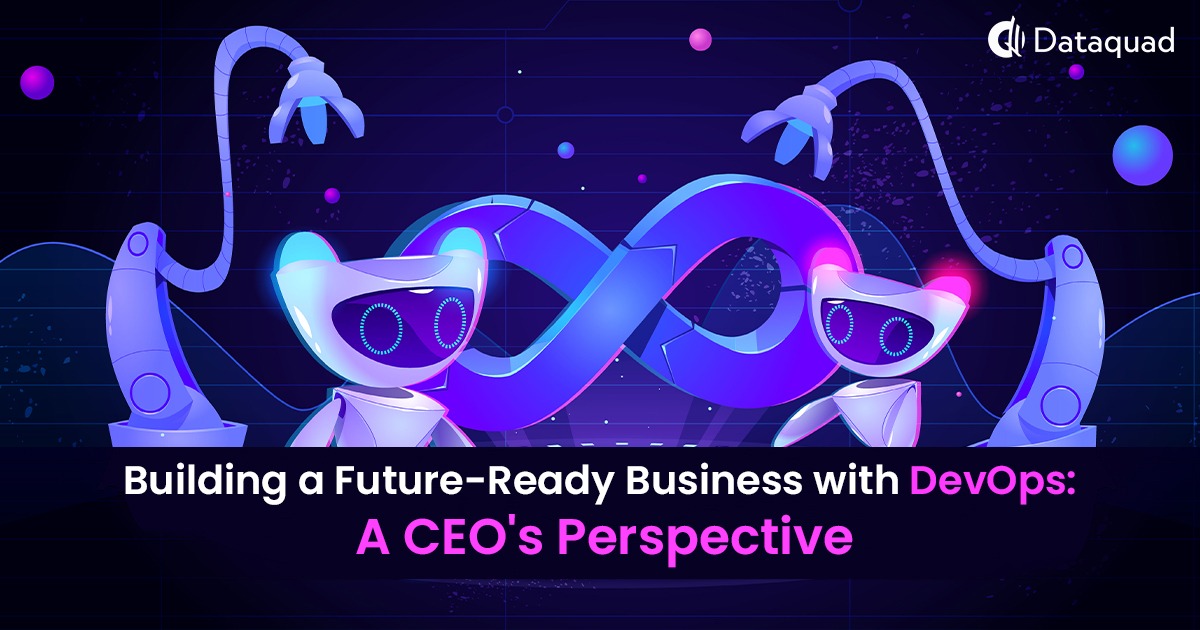Building a Future-Ready Business with DevOps: A CEO’s Perspective

Digital solutions are becoming the oxygen for all businesses, allowing them to operate at market speed. Digital is now mainstream in all businesses and all industries; it is no longer limited to well-known tech titans and unicorn startups.
Many businesses seek to enhance their delivery strategy to increase the bar. A DevOps mentality is critical for faster releases and improved development. IT operations have been transformed due to the DevOps transformation, which has united teams without wasting time or effort to move forward.
While 46% of enterprises polled by Atlassian are still new to DevOps, initiating a DevOps transformation in 2023 would allow businesses to optimize resources, speed software delivery, and effectively answer market needs.
Learn how to create a DevOps transformation strategy and reimagine how you develop, test, deliver, and maintain software solutions.
Understanding DevOps Transformation
Before we create a plan for DevOps transformation, let’s define DevOps transformation as a process. DevOps transformation can be characterized as adopting an Agile-inspired strategy for bridging the gap between development and operations teams, improving their collaboration, reducing the system development lifecycle, and ensuring the continuous delivery of higher-quality software.
According to this definition, DevOps transformation necessitates utilizing DevOps automation tools and simultaneously reinventing software development toolkits and development culture. In turn, the latter should adhere to the core DevOps concepts of collaboration, data-driven and customer-centric decision-making, constant feedback and improvement, shared responsibility, and automation.
Rewriting The Operating Model: Speed-To-Market
Moving to the future of IT requires fundamentally altering the IT operating model- how the IT estate delivers value to the business – to enable connected enterprise benefits. This necessitates the adoption of an ecosystem of federate IT, business-led capabilities, and external partners by several businesses. Instead of a single monolithic structure, the future operating model will combine diverse structures and speeds tuned to fulfill product or service requirements.
The rewriting of old to contemporary delivery operating models realigns skills and personnel from segregated projects and run operations to full-stack customer experience teams, enabling rapid and scalable delivery of new goods and services. Being able to adapt delivery based on market demands and recognizing that not all items must be provided at the same rate to optimize value is crucial.
The future of the IT operating model is a realization that the enterprise’s DNA must evolve, that the supply and demand IT era is past, and that monolithic organizational structures do not support the customer experience success. Each company must determine how much of an ingredient is required to deliver value. Over the next five years, most organizations will invest in achieving the optimal mix.
Atlassian’s poll reveals that 99 percent of enterprises understand that DevOps transformation positively influences their operations. The following are the primary added-value benefits they reported.
Superior-Grade Deliverables
DevOps is a method that facilitates the delivery of faster, higher-quality deliverables. It largely relies on data to help the product owner and end users define and prioritize the most critical concerns. Businesses can improve the quality of their deliveries from cycle to cycle by addressing these issues at the outset.
Faster Time To Market
DevOps improves time-to-market by automating testing, which increases the team’s efficiency, enables them to avoid time-consuming and repetitive chores, and drastically minimizes the likelihood of error. With a well-considered DevOps transformation strategy in place, you can deliver more quickly by aligning the needs of your developers and IT operations staff. In addition, you may boost team productivity by offering visibility into how long tasks take to complete, allowing you to align resources with demand better.
Improved Deployment Frequency
In addition to boosting deployment frequency and fulfilling higher-level business requirements, the DevOps transition entails increasing deployment frequency. Continuous deployment is one of the DevOps methodology’s pillars that help tech teams to respond more quickly to changing market demands by introducing new features on the fly. Moreover, the quality of each new piece of the software remains high thanks to automated testing, enhanced collaboration, and continual feedback.
Improved Team Dynamics And Collaboration
Transformation to DevOps is about enhancing the organization’s culture and streamlining collaboration between the development and operations teams. It promotes the exchange of ideas and frequent communication. According to this viewpoint, DevOps transformation aims to create a more agile, collaborative workforce that can swiftly adapt to business demands.
Reduced Recuperation Time
In addition to faster release timelines, another primary advantage of DevOps transformation is faster problem resolution timeframes. Additionally, it enables enterprises to retain high levels of data security without affecting developer productivity or creativity. DevOps as a technique also advocates viewing failure as a learning opportunity and searching for solutions to prevent future failures due to the exact causes.
Improving The Quality Of Products And Services
The DevOps methodology necessitates fast product development cycles and frequent customer, stakeholder, and product owner feedback. Beginning the next cycle with direct input in mind enables the development of products and services that are fully aligned with corporate objectives and consumer expectations. This benefit of DevOps transformation makes DevOps particularly relevant for SaaS projects, which should be equally focused on product quality and the service it provides.
Lower New Release Failure Rates And Fewer Accidents
Since the DevOps methodology fosters a more collaborative environment between the development and testing teams, drastically reducing the likelihood of overlooking a significant bug. Additionally, the notion of continuous testing allows no possibility for security flaws. This benefit is crucial for high-risk businesses, making DevOps for fintech or governance even more critical.
Utilization Of Automation Tools And Technology To Their Maximum Capacity
Automation of processes is the driving factor behind DevOps. Although you cannot automate everything, you should automate the following essential processes:
Continuous delivery and integration (CI/CD). Automating a CI/CD pipeline is a method for reducing time to market, mitigating risk, and increasing overall efficiency.
Provisioning. Automated provisioning provides instances on demand by allocating only the required computing resources.
Application deployment. Automated application deployment expedites software delivery from testing to production environments.
Software testing is performed. By executing automated testing scenarios, it is possible to discover difficult-to-detect faults with fewer resources.
Log management. The purpose of log management automation is to facilitate error discovery and resolution.
Automated app performance monitoring enables developers to swiftly address performance concerns after adding a new feature.
Continuous Evaluation Of DevOps Performance
DevOps is a data-driven practice, which is one of its effective characteristics. Utilizing automation technologies, such as those for DevOps performance monitoring, simplifies data collection and analysis. You must monitor four key performance indicators (KPIs): deployment frequency, lead time for modifications (code commit to code deploy), mean time to restore (MTTR), and change failure rate.
Adopting the Agile project management structure
Agile project management and the DevOps technique are an ideal fit. They represent adaptability, collaboration between the team and the customer, open and regular communication, and rapid response to change. Managing your project in an Agile manner involves foresight. Therefore, if you are just beginning your development adventure, consider employing a dedicated team with prior expertise using this technique.
Wrapping Up
Dataquad is the starting point for your DevOps transition.
Starting your DevOps transformation now gives you a future-proof chance to reduce expenses, accelerate the development process, minimize costly errors, and produce higher-quality software, especially if you consider outsourcing DevOps-as-a-service.
Relevant Software will assist you in establishing a top-notch DevOps transformation team as the initial step in achieving these objectives simultaneously. We have already helped over fifty firms establish intelligent DevOps strategies by sharing our practical experience and skills and utilizing a cutting-edge DevOps toolkit.
Contact our DevOps transformation team to recruit staff with the required technical expertise and a forward-thinking attitude.
Have Any Question?
- (832) 861-1004
- hr@dataqinc.com




